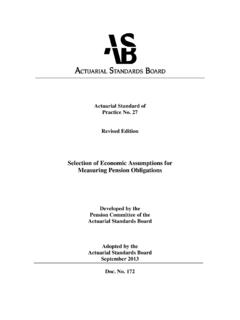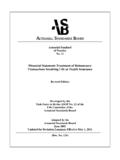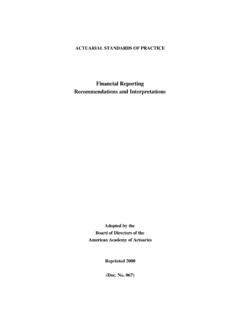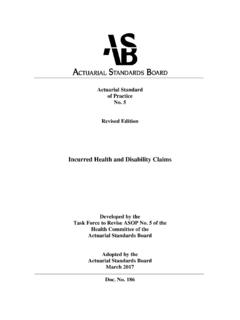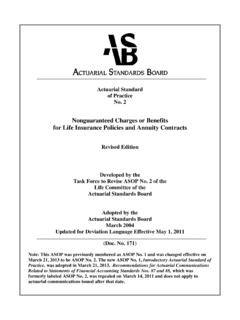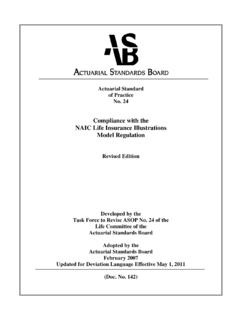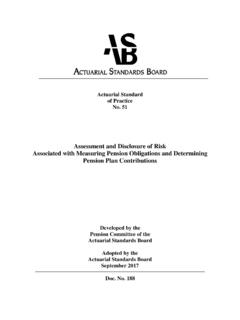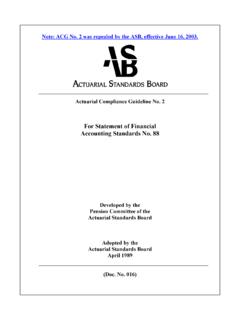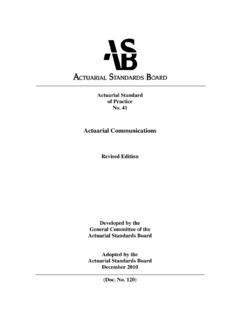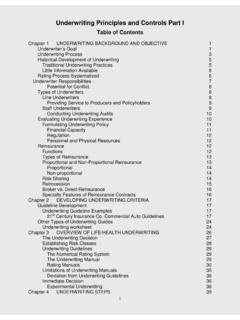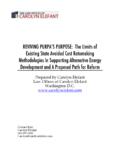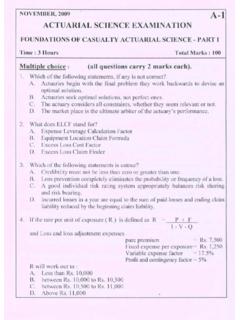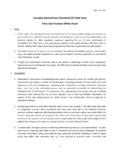Transcription of Treatment of Catastrophe Losses in …
1 Actuarial Standard of Practice No. 39 Treatment of Catastrophe Losses in property / casualty insurance ratemaking Developed by the Subcommittee on ratemaking of the casualty Committee of the Actuarial Standards Board Adopted by the Actuarial Standards Board June 2000 Updated for Deviation Language Effective May 1, 2011 (Doc. No. 156) ASOP No. 39 June 2000 ii T A B L E O F C O N T E N T S Transmittal Memorandum iii STANDARD OF PRACTICE Section 1. Purpose, Scope, Cross References, and Effective Date 1 Purpose 1 Scope 1 Cross References 1 Effective Date 1 Section 2. Definitions 2 Catastrophe 2 Catastrophe ratemaking Procedures 2 Contagion 2 Demand Surge 2 Section 3. Analysis of Issues and Recommended Practices 2 Identification of Catastrophe Perils or Events 2 Identification of Catastrophe Losses 2 The Use of Data in Determining a Provision for Catastrophe Losses 3 Use of Historical insurance Data 3 Use of Noninsurance Data and Models 4 Using a Provision for Catastrophe Losses 5 Loss Adjustment Expenses 5 Section 4.
2 Communications and Disclosures 5 Conflict with Law or Regulation mentation and Disclosure 5 Documentation and Disclosure 5 Disclosures 6 APPENDIXES Appendix 1 Background and Current Practices 7 Background 7 Current Practices 8 Appendix 2 Comments on the 1999 Exposure Draft and Subcommittee Responses 10 ASOP No. 39 June 2000 iii June 2000 TO: Members of Actuarial Organizations Governed by the Standards of Practice of the Actuarial Standards Board and Other Persons Interested in the Treatment of Catastrophe Losses in property / casualty insurance ratemaking FROM: Actuarial Standards Board (ASB) SUBJ: Actuarial Standard of Practice (ASOP) No. 39 This booklet contains the final version of Actuarial Standard of Practice No. 39, Treatment of Catastrophe Losses in property / casualty insurance ratemaking . Background Many property / casualty insurance products are, by their nature, subject to large aggregate Losses resulting from relatively infrequent events or natural phenomena, , from catastrophes.
3 These Losses can cause extreme volatility in historical insurance data and generally require separate and different Treatment from other Losses in ratemaking methodologies. Historically, the most common method was to calculate the ratio of actual Catastrophe Losses to noncatastrophe Losses over a longer experience period, and apply that ratio to expected noncatastrophe Losses in the ratemaking formula. In 1992 and 1994, two events occurred that changed the actuarial profession s view of Catastrophe Losses . The Hurricane Andrew and Northridge Earthquake catastrophes clearly demonstrated the limitations of relying exclusively on historical insurance data in estimating the financial impact of potential future events. In addition, property / casualty insurers (including self-insurers) and their actuaries began to focus on the impact that large individual events or sequences of events could have on the insurers solvency, cash flow, and earnings. This actuarial standard of practice is intended to provide guidance to actuaries in evaluating Catastrophe exposure and in determining a provision for Catastrophe Losses and loss adjustment expenses in property / casualty insurance ratemaking .
4 Exposure Draft This standard was exposed for review in February 1999, with a comment deadline of June 15, 1999. Fourteen comment letters were received. The Subcommittee on ratemaking reviewed all the comments carefully, and many of the suggestions were incorporated in the final standard. In particular, the subcommittee did the following: (1) revised the title and the scope of the standard to more explicitly recognize that the standard applied to ratemaking ; (2) revised the text to ASOP No. 39 June 2000 viindicate that the actuary was estimating a Catastrophe provision not estimating actual Catastrophe Losses ; and (3) more explicitly recognized that, in the end, the procedure that the actuary uses must reflect the expected frequency and severity distribution of catastrophes, as well as the anticipated class, coverage, geographic and other relevant exposure distributions. For a summary of the substantive issues contained in these fourteen comment letters and the task force s responses, please see appendix 2.
5 The subcommitee and casualty Committee thank all those who commented on the exposure draft. The subcommittee also thanks former member Robert W. Gossrow for his contributions during the development of this proposed ASOP. The ASB voted in June 2000 to adopt this standard. Subcommittee on ratemaking of the casualty Committee Patrick B. Woods, Chairperson Mark S. Allaben R. Michael Lamb Charles H. Boucek Marc B. Pearl Frederick F. Cripe Jonathan White Gregory L. Hayward Paul E. Wulterkens casualty Committee of the ASB Michael A.
6 LaMonica, Chairperson Christopher S. Carlson Robert S. Miccolis Anne Kelly Karen F. Terry Ronald T. Kozlowski William J. VonSeggern Robert J. Lindquist Patrick B. Woods Actuarial Standards Board Alan J. Stonewall, Chairperson Phillip N. Ben-Zvi Roland E. King Heidi R. Dexter William C.
7 Koenig David G. Hartman James R. Swenson Ken W. Hartwell Robert E. Wilcox ASOP No. 39 June 2000 1 ACTUARIAL STANDARD OF PRACTICE NO. 39 Treatment OF Catastrophe Losses IN property / casualty insurance ratemaking STANDARD OF PRACTICE Section 1. Purpose, Scope, Cross References, and Effective Date Purpose The Statement of Principles Regarding property and casualty insurance ratemaking of the casualty Actuarial Society states that consideration should be given to the impact of catastrophes and that procedures should be developed to include an allowance for Catastrophe exposure in the rate. The purpose of this actuarial standard of practice (ASOP) is to provide guidance to actuaries in evaluating Catastrophe exposure and in determining a provision for Catastrophe Losses and loss adjustment expenses in property / casualty insurance ratemaking .
8 Scope This standard provides guidance to actuaries when performing professional services in connection with ratemaking for property / casualty insurance coverages including property / casualty risk financing systems, such as self- insurance or securitization products, which provide similar coverage. If the actuary departs from the guidance set forth in this standard in order to comply with applicable law (statutes, regulations, and other legally binding authority), or for any other reason the actuary deems appropriate, the actuary should refer to section 4. Cross References When this standard refers to the provisions of other documents, the reference includes the referenced document as it may be amended or restated in the future, and any successor to it, by whatever name called. If the amended or restated document differs materially from the originally referenced document, the actuary should consider the guidance in this standard to the extent it is applicable and appropriate.
9 Effective Date This standard will be effective for work performed on or after December 15, 2000. ASOP No. 39 June 2000 2 Section 2. Definitions The definitions below are defined for use in this actuarial standard of practice. Catastrophe A relatively infrequent event or phenomenon that produces unusually large aggregate Losses . Catastrophe ratemaking Procedures ratemaking procedures that adjust for the impact of Catastrophe Losses in the experience data and determine a provision for Catastrophe Losses and loss adjustment expenses. Contagion A lack of independence between the occurrence of Losses among different entities. Demand Surge A sudden and usually temporary increase in the cost of materials, services, and labor due to the increased demand for them following a Catastrophe . Section 3. Analysis of Issues and Recommended Practices In evaluating Catastrophe exposure and in determining a provision for Catastrophe Losses and loss adjustment expenses in property / casualty insurance ratemaking , the actuary should be guided by the following sections.
10 Identification of Catastrophe Perils or Events The actuary should take reasonable steps to identify the perils or events that have the potential to generate Catastrophe Losses that differ materially from the expected aggregate Losses or the expected distribution of Losses . These perils or events have at least one of the following characteristics: a. The Potential to Display Contagion Examples of perils that display contagion include windstorms, earth movement, and freezing. b. Infrequent Occurrence Some events that occur infrequently have the potential to produce Losses that can significantly distort the historical experience. An example of such an event is an explosion that results in the release of toxic material. If the experience data contain such events, using this experience data without adjustment may overstate the Catastrophe provision in the rates. If the experience data do not contain such events, using this experience data without adjustment may understate the Catastrophe provision in the rates.
